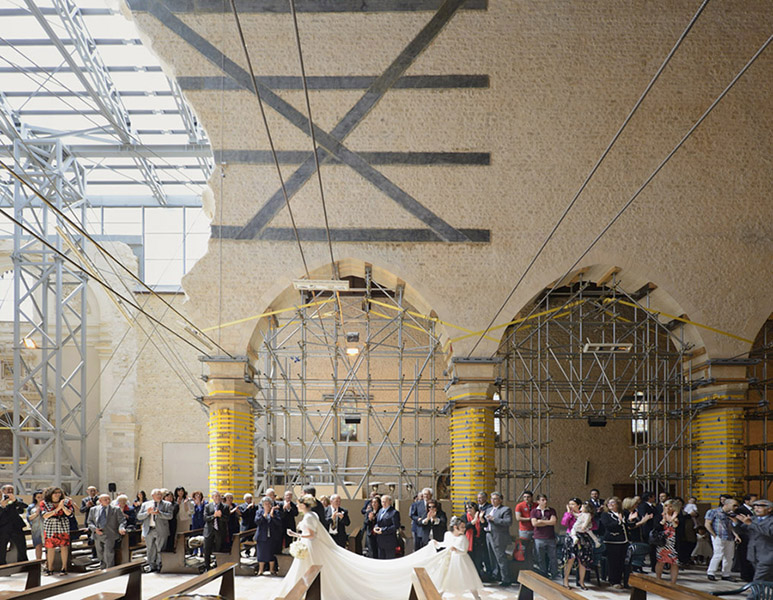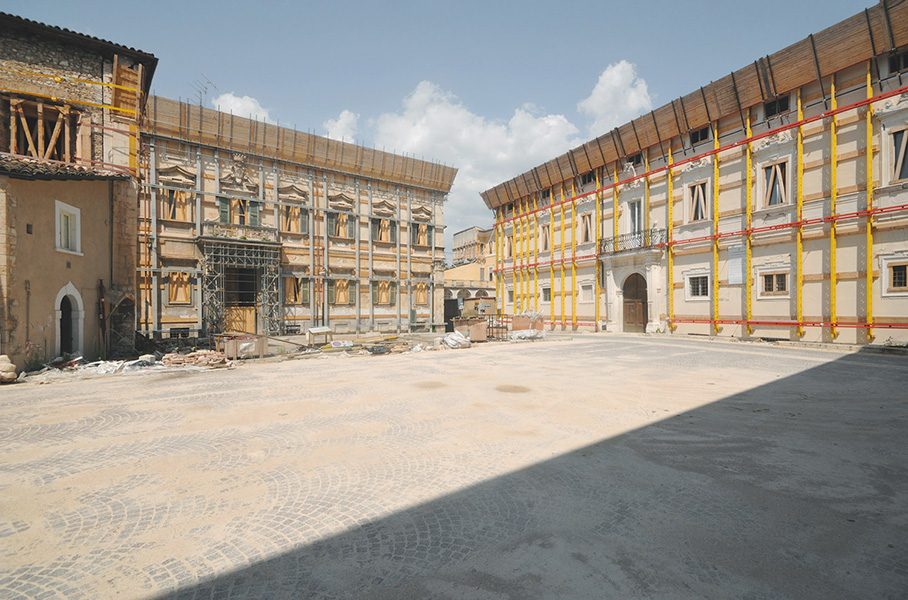Suspended City: L’Aquila after the Earthquake
Suspended City: L’Aquila after the Earthquake
The photographs taken by Michele Nastasi of L’Aquila after the earthquake lay the city
bare as a place where it has become impossible to live: a deserted and surreal
landscape, choked with structures shoring up the buildings and fixing the city in a state
of suspension without any time limit. Three hundred and eight people died in the
earthquake that struck L’Aquila on 6 April 2009, while 70,000 were evacuated and over
eighty for cent of the buildings in the historic centre were severely damaged; the city’s
heart, much of it impassable, was declared a ‘Red Zone’ and closed off to everyone.
The photographs conjure up images of surgery: prostheses, braces and splints stabilize
the body of the city, but while the operations have been a technical success, the patient
shows no signs of life. The picture of L’Aquila presented is not just a record of the
catastrophe of the earthquake and its aftermath, but an image that at a distance of
years has become exemplary of some decisive changes underway in the whole of
European and Western culture. What are brought into focus in this book are the shift
in political paradigms and the nature of government action, the febrile relationship of
culture with history and the need to restore the experience of the community and
urban living to its central role as a forge of identity.
“Suspended City” began in 2010 in the editorial staff of “Lotus international”, on which
it is initially published (Lotus 144, 2010). The photographic series was then expanded,
and exhibited at the MIT Museum in Cambridge (Boston) in 2013, at the Photography Festival
in Ragusa (2013), at the Expowall Gallery in Milan (2016), and in other group exhibitions.
In 2015 “Suspended City” became a book, published in two editions (Italian and English):
Michele Nastasi “Suspended City: L’Aquila after the earthquake”, edited by Maddalena
d’Alfonso, foreword by Giorgio Agamben (New York: Actar D., 2015).
Buy “Suspended City” on amazon.com
Compra “Città sospesa” su amazon.it
SECURITY CITY
by Giorgio Agamben (foreword to “Suspended City: L’Aquila after the Earthquake”)
“As happens with every photographer faithful to the original calling of his trade, Nastasi’s
pictures of L’Aquila are the vehicle for a political prophecy.
This prophecy concerns the paradigm of the city as it is imagined or dreamed, more or less
consciously, by the ruling powers of the post-industrial and post-democratic societies in
which we live. This authority is no longer the sovereign state of the ancien régime nor the
“disciplinary state” described by Michel Foucault. Nor is it, as some would claim, a state
in which the rule of law holds. Instead we might call it, to borrow a term already used by
political commentators in the United States, a security state. A system in which, according
to the message that is drummed into us everywhere and at every moment, ‘reasons of security’
have taken the place, as arcanum of power, of the “reason of state.”
Foucault showed that when security appeared for the first time as a paradigm of government
in Quesnay and the Physiocrats, the aim was not to prevent natural disasters and
insurrections, but to let them happen and then to intervene, once they had occurred, in such
a way as to gain advantage from them. The main problem faced by governments of the time was
famine, which they sought to prevent by setting up public granaries and banning the export
of the cereals. On the contrary, given that prevention had proved counterproductive,
Quesnay proposed letting famines happen and intervening at the opportune moment to liberalize
trade. Thus catastrophe was transformed, at least for some, into economic gain. It is in
terms of this model that we should understand security as the current paradigm of government,
both in international politics, as American policy after 9/11 clearly shows, and in domestic
politics, in accordance with the neoliberal principle that crisis can be used as a means of
capital accumulation.
In the case of L’Aquila too, nothing was done to prevent the catastrophe but, once the
earthquake had happened, an attempt was made to create the kind of city of which the security
state dreams. Nastasi’s photographs, at once incomparable and appalling, show us a city that,
as on the title page of Hobbes’s Leviathan, has been emptied of its inhabitants. Instead of
the life that animated its streets and squares, everywhere gates, cages, by-passes,
scaffolding and fences that do not evoke, however, works of restoration, but seem to want to
fix the state of emergency as a paradigm of government with no time limit. Something similar
had been staged temporarily in Genoa in July of 2001, when a police officer declared candidly
that the government did not want the police to maintain order, but to manage disorder. The
disaster carefully prolonged and preserved, the emergency turned into normality, the city as
a place where it is impossible to live: this is the lucid, implacable message that Nastasi’s
lens conveys in such a masterful way.”


